Specialized set out to solve a common problem in the kids bike world – kids grow out of their bikes so quickly! Enter the Specialized Jett. But how well does the Jett actually solve this problem? And is it worth paying extra for? That’s what we’re on a mission to find out!
We put the Jett to the test in the real world with 8 different kids aged 7 to 12 to see just how well the Jett adjusts to different heights. In this review, we’ll break down just what makes the Jett different and show you (not just tell you!) how the Jett meets the needs of growing kids.
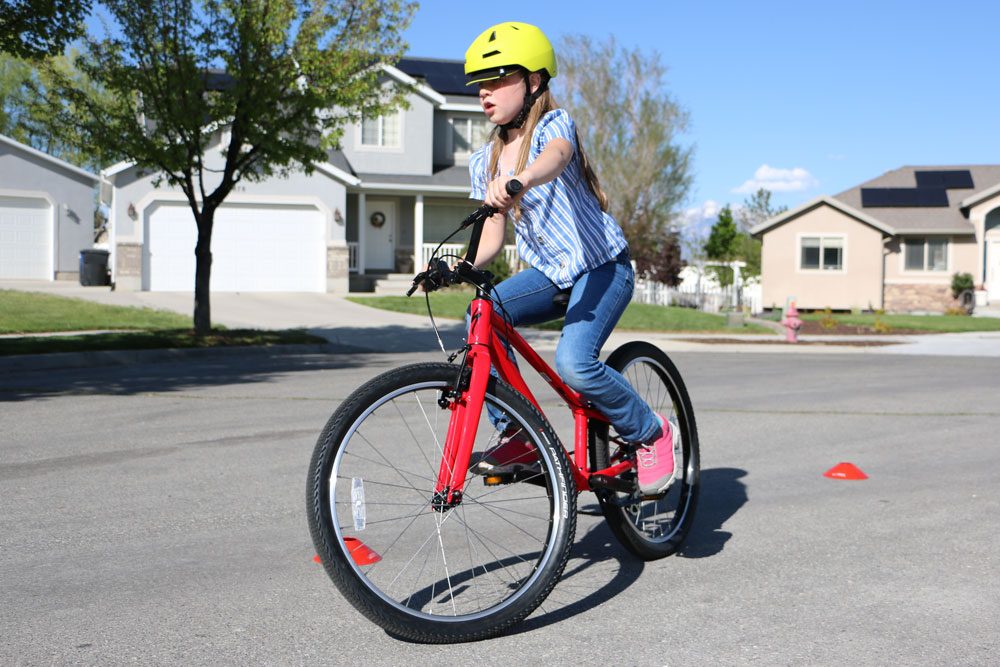
Beyond fit, we’ll also dive into why the Jett is an all-around amazing bike that many of our testers (who regularly ride high-end kid bikes) deemed, “the best bike ever!” Setting a new standard for “bike shop bikes”, the Jett is proof that major bike manufacturers aren’t completely out of the game and can produce quality, lightweight kids bikes comparable to many high-end consumer-direct brands.
Read our full review below to discover why our test riders were all begging for more time on the Specialized Jett!
Specialized Jett Kids Bike Overview

RATING: Exceptional
MSRP: $199 (16″), $299 (20″), $399 (24″)
BEST FOR: Everyday riders sticking mainly to pavement
SPECIFICATIONS
SEAT HEIGHT: 26.5″ – 35.5″ (24″ size)
WEIGHT: 22.3 lb. (24″ with pedals and kickstand)
GEARS: 8 speed (24″), 7-speed (20″), single speed (16″ and 20″ single)
SHIFTER: microSHIFT trigger shifter (double thumb push)
BRAKES: Standard v- brakes
FRAME/FORK: Alloy aluminum frame and fork
TIRES: 2.0″ wide Specialized Pathfinder Sport on all models
PROS:
- Built-in adjustability to allow kids to properly fit and ride the Jett for longer than most bikes
- Lightweight, aluminum construction
- Easy-to-use trigger shifters (on geared 20″ and 24″)
- Smooth-rolling tires that provide plenty of cushion and traction
- Quality build that will hold up through several kids
- Support and assembly from your local Specialized dealer if needed (bikes also shipped direct to you if you prefer!)
- Cushioned child-size saddle with numbered seat post for a precise fit
- Narrow q-factor for efficient pedaling
- Ergonomic handlebar grips
CONS:
- Higher cost (but often found on sale!)
Specialized Jett – Video Review
Visual learner? See the Specialized Jett in action in this video review!
Specialized Jett Kids Bike – Review Outline
Specialized Jett Kids Bikes – What makes them unique?
The Jett has a few unique tricks up its sleeve that truly makes it stand out, especially when compared to the kids bikes offered by most major bike manufacturers that are sold at local bike shops.
First and foremost, the Jett is designed to be a better fit for a longer period of time. The Jett’s adjustment features allow parents to extend the “sweet spot” of proper fit on a bike.
Most kids can technically ride a bike for 2 to 3 years, but they actually only properly fit on the bike for one of those years. During the last year or so, the bike’s seat typically can’t go high enough and the handlebars are too close to the rider and too low to provide a really great fit.
With a longer seat post as well as adjustable handlebars, the Jett sets itself apart from other bikes for its ability to adjust to a wider range of heights. In fact, due to this adjustability, Specialized claims that kids can properly fit on the Jett for 50% longer than other kids’ bikes (or 3 summers).
Does the Jett actually live up to this claim? We put 8 kids aged 7 to 12 on the Jett 24 to see how well the bike adjusted to their various heights. Keep reading to discover the results of our extensive testing!
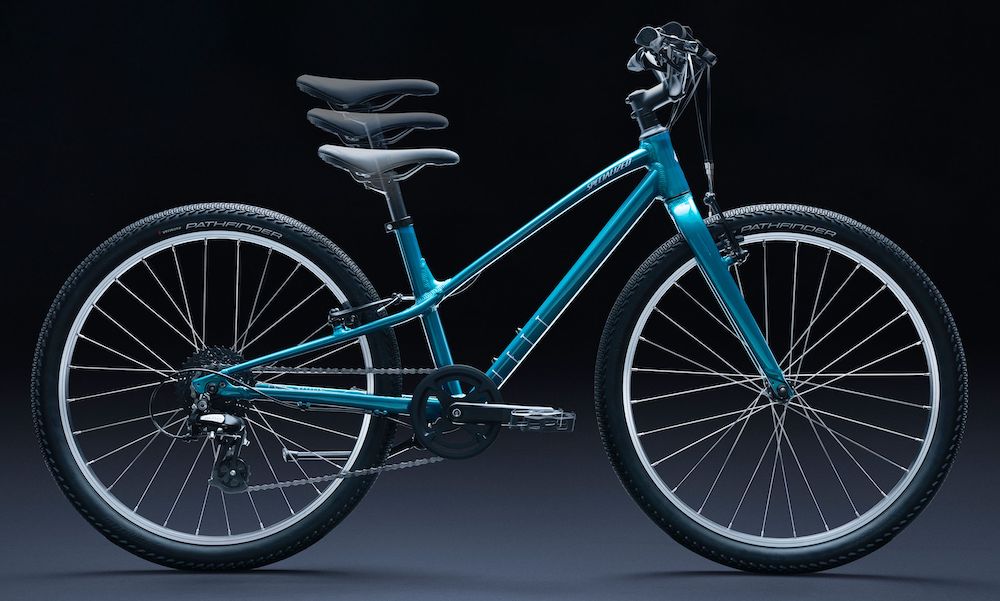
Second, the Specialized Jett is lightweight. Kids bikes found at local bike shops are almost always great quality, but they are very heavy as compared to online boutique brands. But with aluminum frames and forks as well as a careful selection of components, the Jett bikes are several pounds lighter than previous Specialized kids bikes and even lighter than many online niche brands.
Third, the Jett is built with kid-specific components. In order to build a bike that will properly fit under a child’s smaller frame, narrower components were selected to provide for a more efficient riding experience (more details below).
Having tested out many different Specialized kids bikes over the years, we can honestly say this is hands down the best kids bike they have ever made. The Jett is in many ways comparable to bikes produced by industry-leading kids brands such as woom, Prevelo and Cleary.
INSIDER TIP! While the adjustability of the Jett is noteworthy, the overall quality of build and components is just as good of a reason to buy the Jett. Seriously, it’s an amazing bike that our testers all raved about and we wish Specialized would have tweaked their marketing of the Jett to focus on more than just fit.
How does the Jett adjust to my child as they grow? What’s the trick?
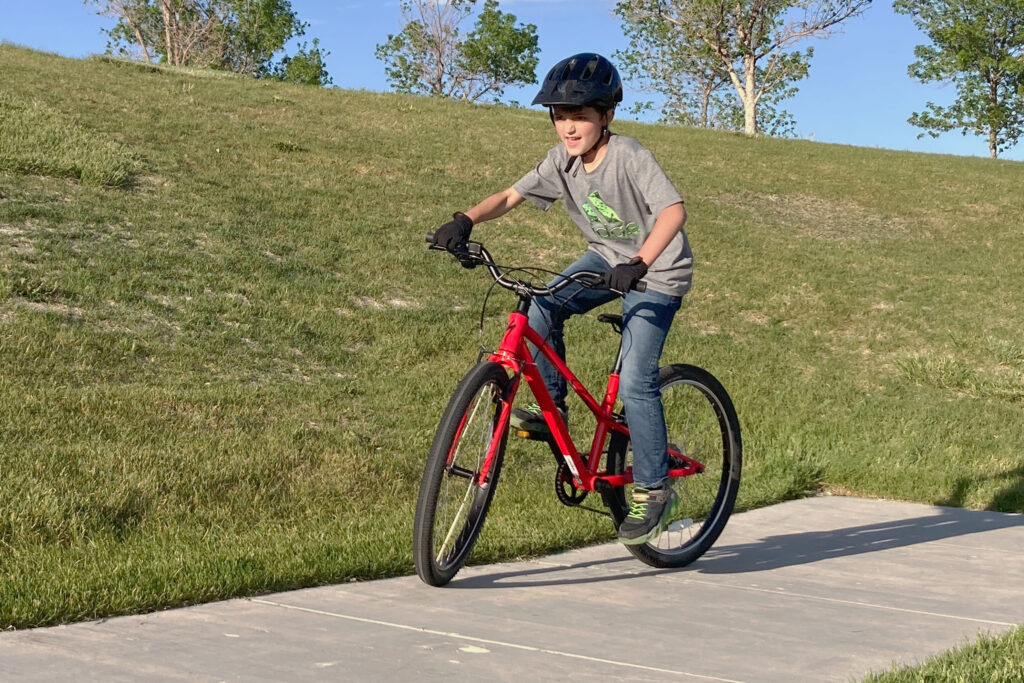
The Jett allows riders to properly fit on the bike for a longer period of time. Specialized accomplished this by carefully designing the individual components on the bike to allow for a wider range of adjustments than the standard kids bike. Extended areas of adjustability on the Jett include:
- Taller seat posts – Provide more height for taller kids while still sliding into the frame to create a low minimum seat height for shorter kids
- Rotating “u-shaped” handlebar – Bars rotate in to decrease the reach for shorter kids and can be rotated back up as the child grows to increase the reach
- Different pedal positions – Pedals can be attached to the crank arms in two different places to accommodate growing legs
THIS SOUNDS COMPLICATED! If the Jett seems like too much for you, trust us, it’s not. The Jett is essentially just like any bike! You can just have your child stand over it and adjust the seat height accordingly. The handlebars and pedal positions can be changed, but that’s not absolutely necessary.
Will the Jett really fit my child longer than other bikes?
Yes! Based on our tests with the Jett 24″, we found it provided about 3 more inches of room for growth on the high end as compared to the Trek Precaliber 24. While not life-changing, those 3 extra inches can certainly extend the life of a bike.
As a comparison, the Specialized recommends the Jett for kids ranging 46″ to 62″ in height (a 16″ range), while the Trek Precaliber 24″ is recommended for heights ranging from 51″ to 59″ (an 8″ range).
As a result of our tests (shown below), we found the Trek’s recommendations to be correct, while the Specialized Jett was closer to 51″ to 62″ (11″ range). Even with the change on the lower end making it about equivalent to the Precaliber, the Jett did in fact provide a better fit for taller kids.
This difference is not surprising when you compare the seat heights of the bikes. The Specialized Jett 24″ and the Trek Precaliber 24″ have similar minimum seat heights (Jett – 26.5″, Trek – 26″), but the Jett has a much higher maximum seat height of 35.5″ versus Trek’s 30.5″.
If we’re being honest, the extended seat post of the Jett 24 is the most significant factor in allowing a child to fit on the Jett longer than other 24 inch bikes. But a very similar result could be achieved simply by buying a longer seat post for the Trek Precaliber 24. While we assume this would be true with the 16″ and 20″, having not tested those sizes, we can’t say for sure.
Beyond seat height, a proper handlebar height is also essential to getting a proper fit. The “u-shaped” handlebars did allow for more height and adjustability as compared to Trek’s flat bar. While not a game-changer, our taller testers definitely felt and appreciated the extra height.
Jett Sizing with Taller Riders
Starting with our tallest 11-year-old 61″ tall tester. With the seat height adjusted properly, the Jett still had several more inches of adjustment available in the seat post. However, it was quickly apparent that the Trek Precaliber’s seat post was not long enough to accommodate his height. With the seat post maxed out, he was able to place his feet squarely on the ground on the Trek. (He should be on tip toes for maximum pedaling efficiency.)
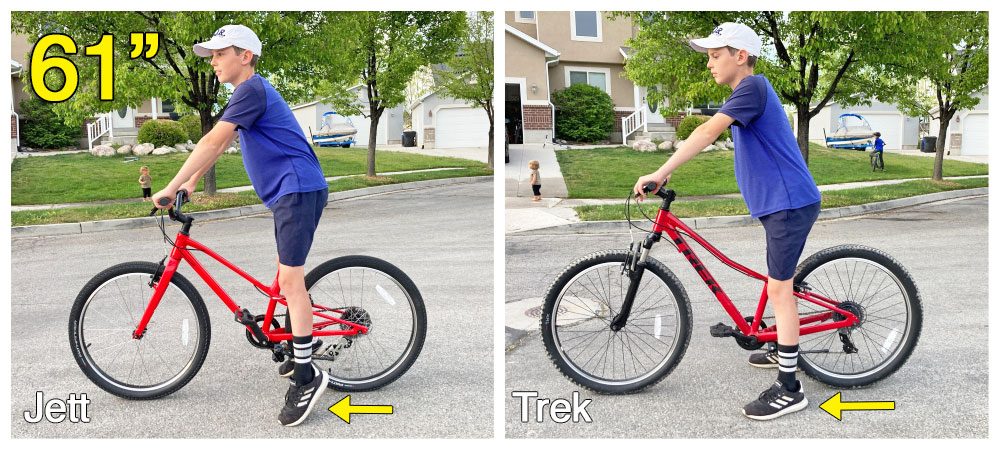
While not a perfect fit, this shows how the Jett offers a more comfortable ride on a bike size that would normally be somewhat awkward for him to ride at this point. Ideally, the handlebars should be able to raised higher, but including a taller handlebar would be problematic for the smallest of riders on the Jett (See below).
Jett with Average-Sized Riders
For the average-sized rider (or those in the mid-range of the Jett’s fit), both the Specialized Jett and the Trek Precaliber provided a great fit. The tester shown below is 9 years old and 53″ tall. The reach on the Trek is longer than the reach on the Jett, but seeing as it is designed for a more aggressive rider than the Jett, that is to be expected.
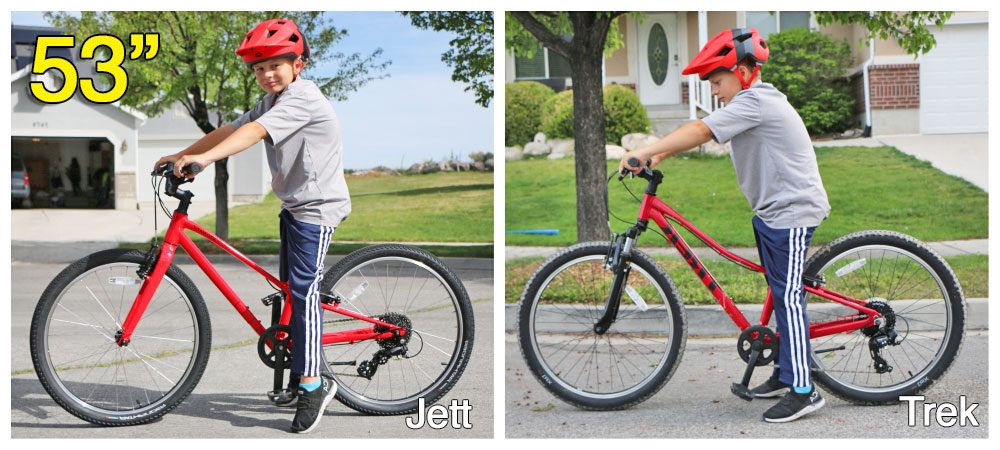
Jett with Shorter/Younger Riders
To test out the low range of the Jett, we put our 48″ tall 7-year-old tester on the Jett and found that he barely fit with the seat post lowered as far down as possible. While he could touch the ground with his tippy-toes, the handlebars were much too high for him to feel comfortable (even with the bars tilted in as recommended by Specialized).
He refused to ride the bike for more than a couple of feet, but the same was true for the Trek Precaliber. Neither bike was a good fit. While this was expected on the Trek, with a minimum height recommendation is 51″, it was unexpected on the Jett with a minimum height listed as 46″.
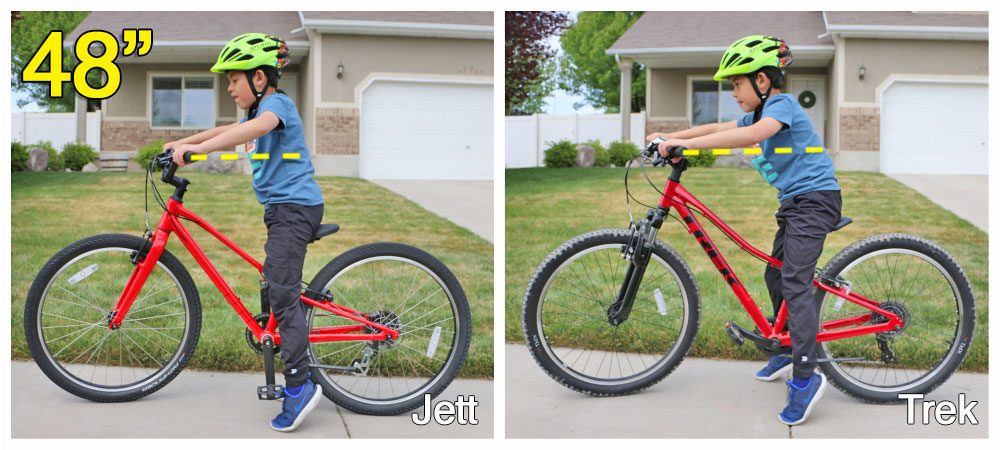
Our 51″ tester, however, had a completely different experience than our 48″ tester. Although he also barely fit on the Jett with the seat post down as low as possible, his longer torso allowed him to gain enough leverage on the handlebars to comfortably and easily ride the Jett. Within minutes of getting started, he was doing wheelies on the bike!
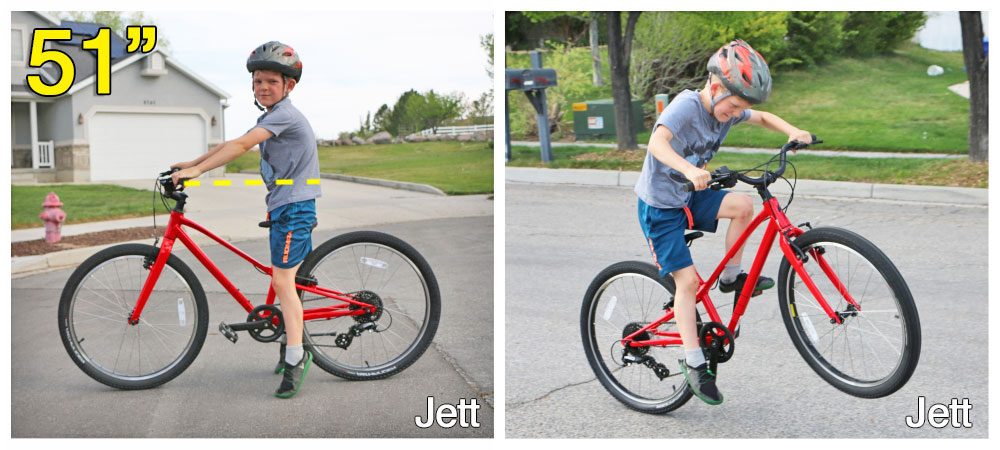
What about adjusting the handlebars and crank arm?
For all of our testers, we adjusted the handlebars forward and back based on their height and reach. While minor in overall fit, the slight changes were certainly noticeable and appreciated by our testers.
During this first round of testing, we did not change the pedal position on the bike as we simply didn’t have time to do so. We will, however, continue to test out the Jett and will report back on the effects of pedal position. Based on our experience with other bikes with varying crank arm lengths, we don’t anticipate the pedal position to play a major role in the fit on the bike.
BOTTOM LINE: While the Jett is an incredible bike that performs like a dream, the adjustable sizing aspect doesn’t have as dramatic an effect as we anticipated. The Jett will provide more room for growth as your child gets taller, primarily because it has a longer seat post. But remember, we only tested the 24″ Jett, and can’t speak yet to the 16″ or 20″ Jett. We do, however, anticipate them offering more room for growth on the high end.
Is the Specialized Jett Kids Bike fun to ride?
1,000% yes! We were honestly surprised at how much our testers all loved riding the Jett. From the smooth-rolling, cushioning tires, to the soft ergonomic grips (more about this below), they all had something to rave about and continually ask to ride it. We have no doubt that any little city rider wouldn’t come to love the Jett.
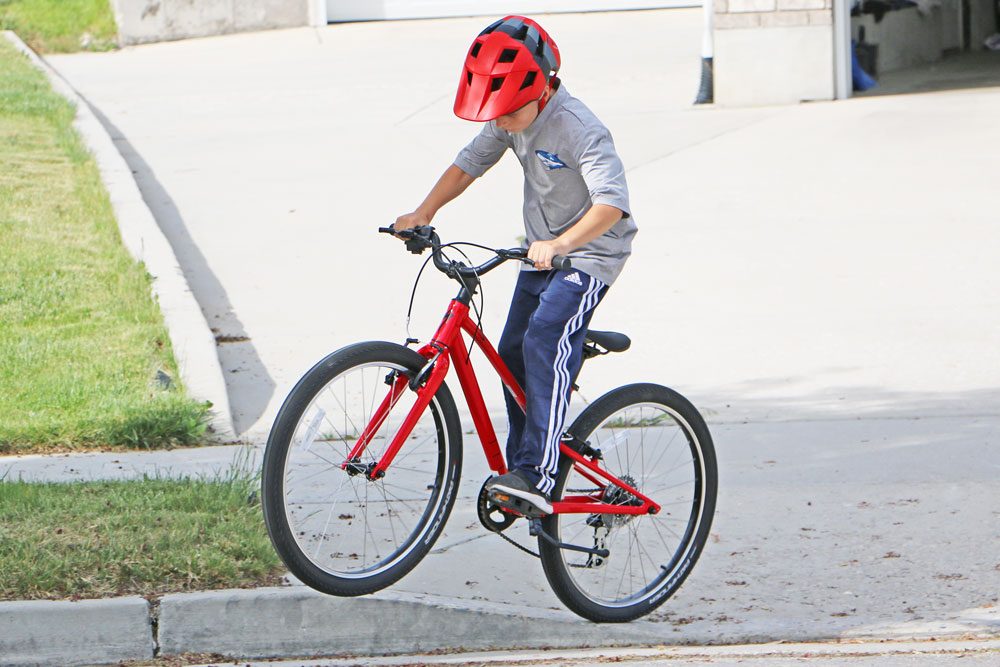
What type of rider is the Specialized Jett kids bike best for?
The Jett is a comfortable and efficient machine that is best suited for city riding. Offering the comfort and smooth riding of a cruiser-style bike, mixed with the technical brawn of a mountain bike, the Jett easily tackles everything from longer paved rides with the family to cruising around the neighborhood with friends.
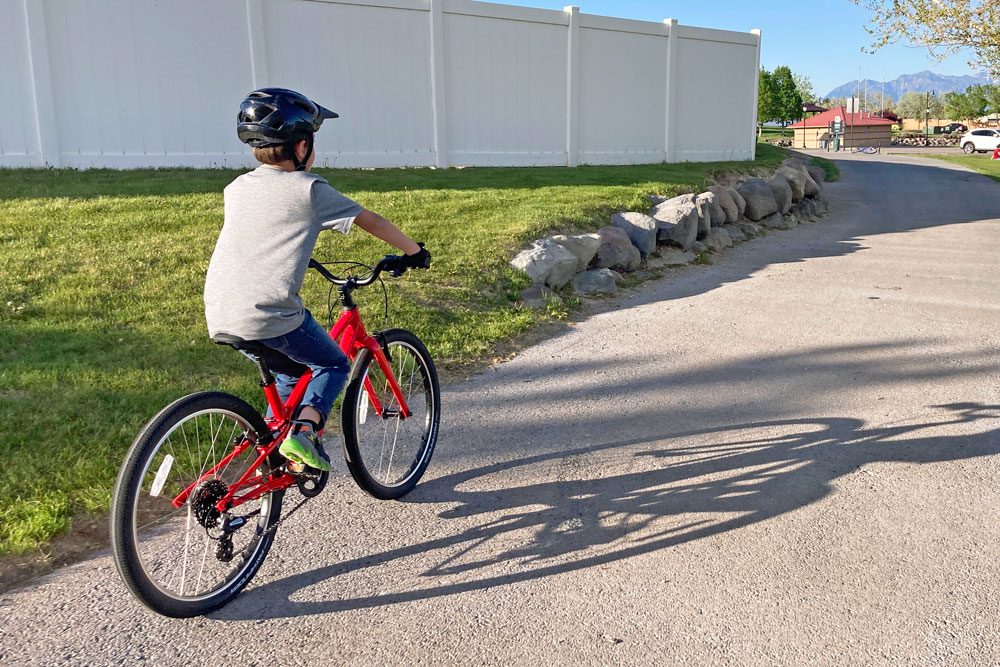
Its lightweight and top-notch components make it super easy to ride because its child-specific components make every pedal stroke more efficient compared to the average kids bike. The ease and efficiency these components provide were previously only available from the high-end niche kids bike brands such as woom and Prevelo.
As a result, the Jett is a great choice for timid riders, but still has plenty to offer for more experienced and aggressive city riders. When put to work on jumps and catching air on curbs, the Jett happily obliged! With thicker tires for added cushion, the Jett’s tires helped to soften the landing.
If your little rider is all about the jumps and tackling the pump track and dirt trails, however, a more aggressive bike, such as the Specialized Riprock, would be a better option.
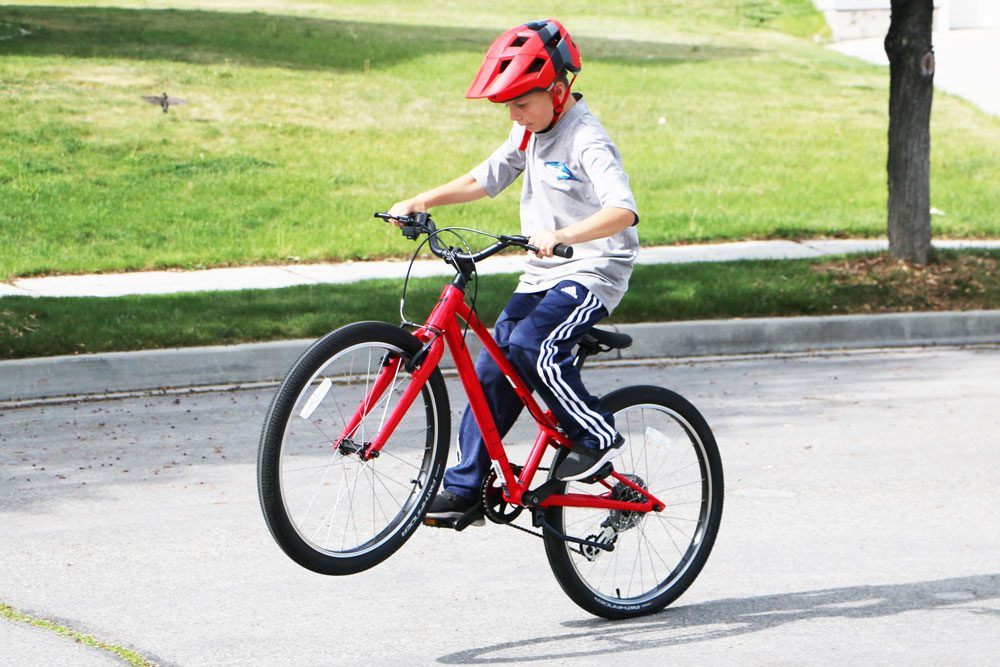
To meet the needs of different ages and riding skill levels, the Jett is available in geared and single-speed models. The 16″ Jett is only available as a single-speed, while the 20″ is available in single speed or geared versions (exact same bike, just different gearing options). The 24″ Jett only comes with gears.
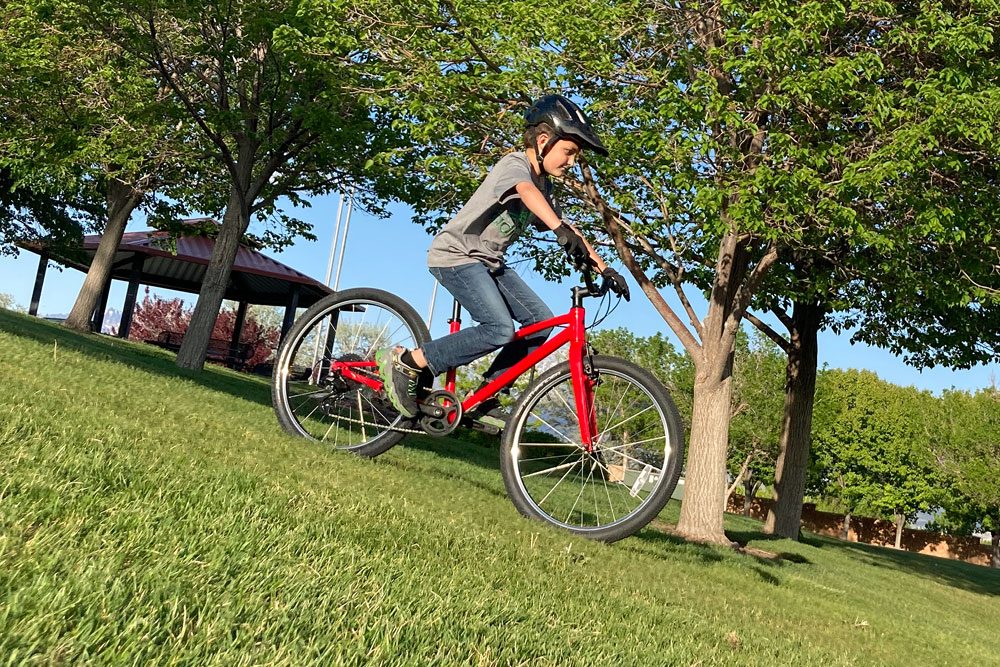
The geared models offer plenty of range for powering up hills or for gaining speed on long straightaways. With easy-to-use trigger shifters and a step up in quality in the derailleur (no basic Shimano Tourney here!), the Jett’s drivetrain is quick and responsive and ready to tackle the wide variety of riding many cities have to offer.
Compared to grip shifters, triggers shifters can be more challenging for some kids to learn on, but the trigger shifter on the Jett 24″ were exceptionally easy for our testers to activate and presented no issues.
What age child fits on the Specialized Jett?
The Jett is available in 16″, 20″ and 24″ wheel sizes which typically fit the age range 4 to 12. All sizes are available at your local Specialized dealer as well as at specialized.com for direct shipping to your house.
| Age Reco | Seat Height Range | MSRP | |
|---|---|---|---|
| Jett 16″ | 4 – 7 | n/a | $450 |
| Jett 20″ Single Speed | 6 – 9 | n/a | $475 |
| Jett 20″ 7 speed | 6 – 9 | n/a | $550 |
| Jett 24″ 8 speed | 8 – 12 | 26.5″ – 35.5″ | $600 |
What if my child is tall or short for their age?
The beauty of the Jett is that you can test one out in person at your local bike shop. If you don’t have a Specialized dealer locally, not to worry, you can compare your child’s inseam to the bike’s minimum seat height to remove some of the guesswork when selecting the right size. (See our Kids Bike Sizing Guide for more information on sizing)
For beginning riders, the minimum seat of a bike height should be as close to their inseam as possible. This allows their entire foot to touch the ground to help them regain their balance or stop the bike if need be.
Older more experienced riders can set the seat 1″ to 4″ above their inseam. The taller and more experienced a rider, the higher the seat can be raised above their inseam.
**Specialized does not provide the minimum seat heights of their bikes, but we will be sure to update the chart above with those measurements as soon as we track them down.**
THIS IS GREAT, BUT WHY SO EXPENSIVE? Previous versions of Specialized kids city bikes (and essentially all bike shop brands) were comparable to an entry-level package on a Toyota, while the Jett jumps all the way up to a Lexus. Both are great, but certainly not built with the same components and comfort features.
Faster, more efficient, and more fun to ride, the Jett isn’t just a package upgrade, it’s a whole new bike! Just like cars, the parts and engineering required to build a better product simply cost more, often a lot more.
Considering kids are behind the wheel here, maximum efficiency is really the main perk here. Kids on the Jett will be able to ride longer without getting as tired as compared to the average kids bike.
Is the Jett worth the added expense? For those who want to shop at their local bike shop, 100% yes. It’s the best city kids bikes you’ll find in a bike shop. For those willing to shop online bikes, the Jett has some tough competition, but certainly is a standout amongst bikes designed for city riding.
A Closer Look at Jett’s Components
Starting from the ground up, the Jett was carefully constructed to fit the needs of young riders. Specialized’s team of engineers and professional bike fitters all came together to select and construct the best components for the Jett.
Seat Post
A seat post seems like an odd component to attempt to improve, but Specialized left no part behind when building the Jett. In order to provide a lower minimum seat height as well as a high maximum seat height (providing lots of room for growth!), the seat post, as well as the frame of the Jett, were modified.
To reach those higher seat heights, the Jett’s seat post is about 60mm longer than average. They also strengthened the post to allow for a smaller 75 mm minimum insertion point (that dashed line on the seat post that tells you not to extend it any further) versus the standard 100 mm. While seemingly minor, this change adds an extra inch of adjustability.
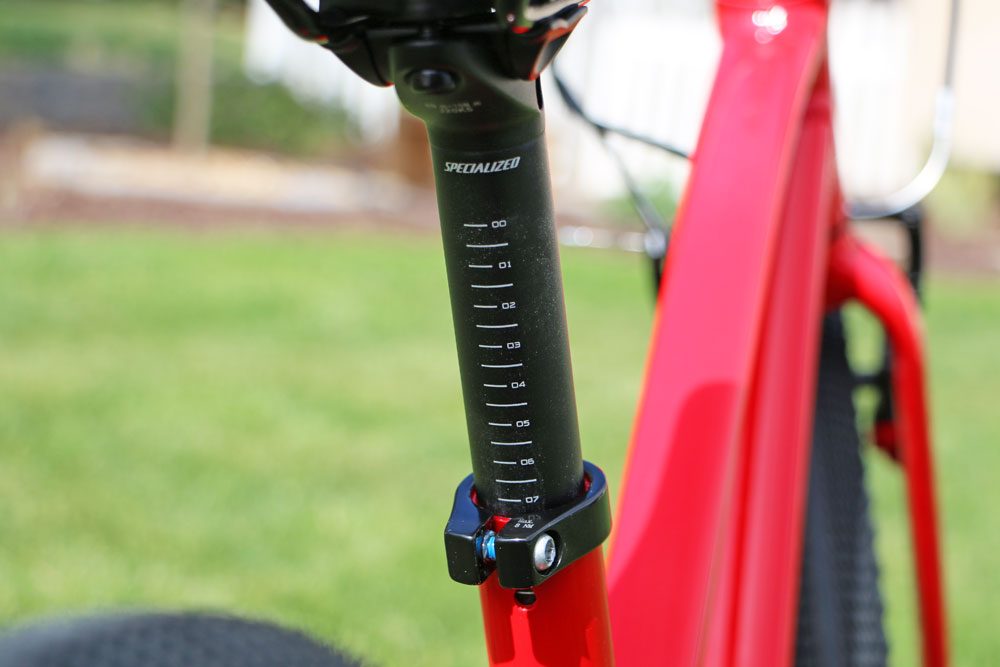
To achieve the Jett’s low minimum seat height, Specialized went to work on the bike’s bottom bracket (the part on the bike where the pedals attach, found at the base of the seat tube). Why the bottom bracket? The bottom bracket of a bike is usually what prevents a bike’s seat from being lowered all the way down to the seat post collar.
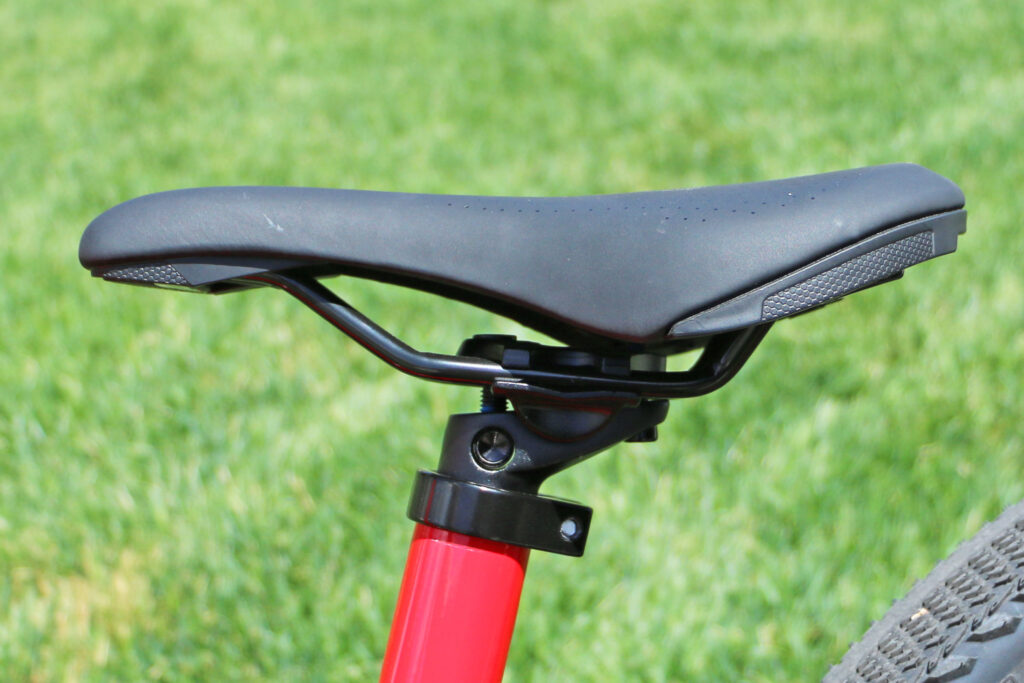
When inserted into the bike’s frame, the welds around the bottom bracket often prevent the seat post from extending all the way down to the bottom bracket. On Jett’s uniquely designed bottom bracket, however, the welds are out of the way to allow the seat post to slide all the way into the frame, allowing for a low minimum seat height.
We saw the importance of this new bottom bracket design when testing out the Jett with our 51″ tester. With the seat lowered all the way to the seat post collar, he was just able to sit on the saddle with his tip-toes touching the ground. Even on the low end of the Jett’s range, it provided a perfect fit for him. If the bottom bracket of the Jett weren’t re-designed or the seat post wasn’t lengthened, it would have been impossible for both our 51″ and 61″ testers to fit on the bike.
U Shaped Handlebars
The handlebars on the Jett are unique as compared to most kids bikes. In addition to being wider to provide more stability, the handlebars also have a deep rise. This “u-shaped” rise allows the reach of the bike to be altered by rotating the bar.
When rotating inwards, the reach on the bike is shortened. This allows younger riders, who barely fit on the bike, to more easily reach the handlebar grips. As the child grows, the bars can be rotated back up to then extend the reach for older/taller riders.
To make adjustments quick and easy, the handlebar is marked with four settings to help you gradually adjust the bar without rotating it too far. While minor, our testers certainly noticed the difference and often asked for the handlebars to be adjusted according to their liking.
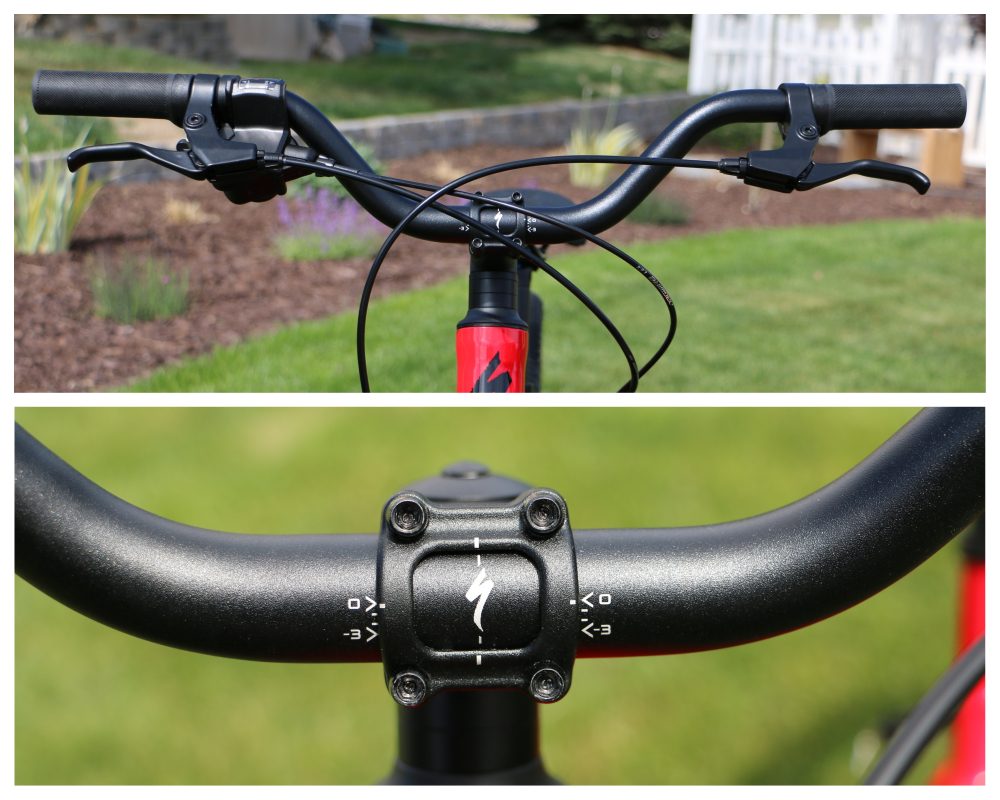
Soft, Ergonomic Grips
Narrower and ergonomic with “wings” for added wrist support, the grips on the Jett are top-notch. In addition to comfortable, grippy soft material, the ergo “wings” help prevent wrist fatigue during longer rides.
In order to keep the wing of the ergo grip in the correct position, when adjusting the handlebar, the grips can also be rotated. By simply loosening a screw on the bottom of the grip, the grip can be rotated into the correct position and then locked backed into place.
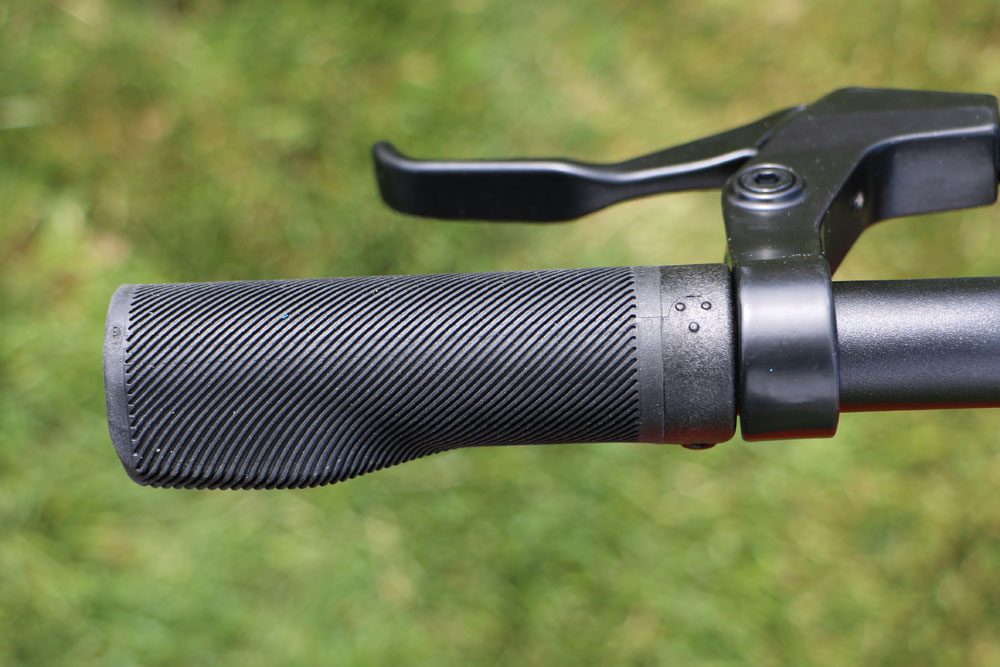
Narrow q-factor and Saddle
The bottom bracket of the Jett was narrowed to allow for a small q-factor. The q-factor of a bike is essentially the distance between the pedals. To allow for maximum efficiency of each pedal stroke, small q-factors are ideal as they allow a child to exert force straight down on the pedal, versus having to splay their legs out to pedal at a wider, less efficient angle.
The kid-specific saddle of the Jett is narrow to prevent leg splay when pedaling. Plenty of padding, as well as a protective plastic rim along the base, comes together to create a comfortable and durable saddle.
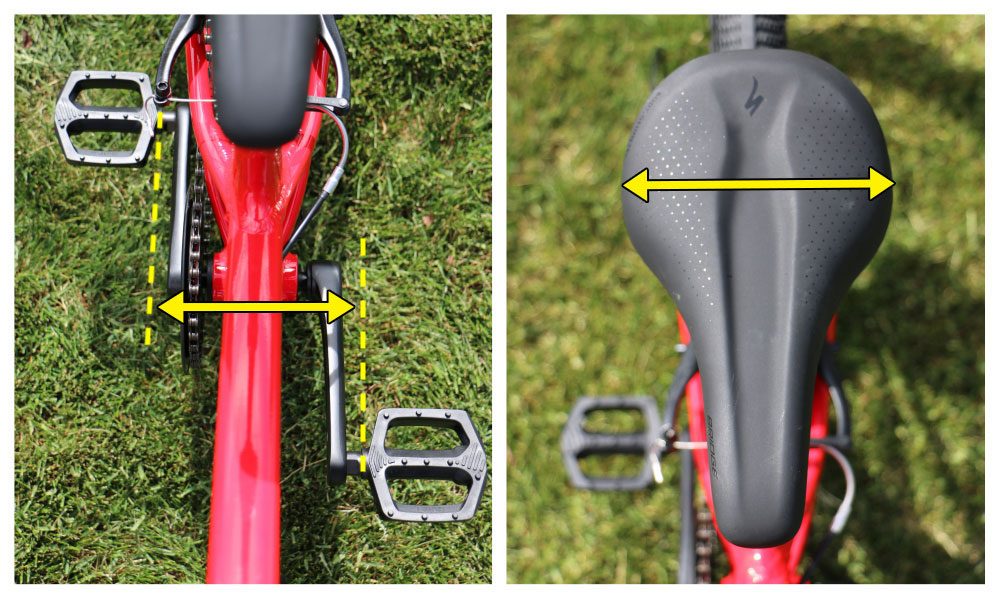
Two pedal insertion points on crank arm
When pushing down on the pedals, getting the right length between the seat and the pedal is also essential. While this distance is usually just obtained by adjusting the seat height, the Jett also allows you to raise or lower the pedal along the crank arm.
The upper pedal position is recommended for shorter riders and average height riders (48″ to 54″) while the lower position for our taller riders. When changed, our testers actually didn’t notice any difference, but it certainly doesn’t hurt to have options and with how easy it is to adjust, it’s worth testing it out with your rider.
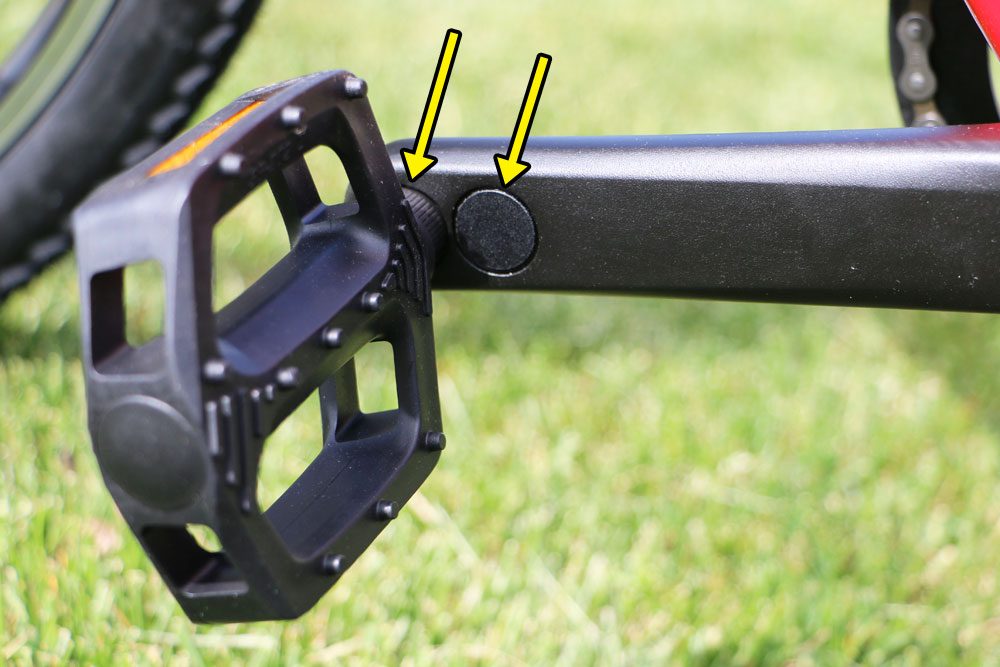
Dual Hand Brakes – No Coaster Brake on Any Size!
All models of the Jett feature powerful v-brakes with easy-reach levers. The Jett 16″, however, is especially unique in that it is the first 16″ bike from Specialized (as well as Trek and Giant) that doesn’t have a coaster brake!
Coaster brakes are especially problematic on smaller kids’ bikes. Young riders often accidentally pedal backward when learning how to pedal. If a bike has a coaster brake, upon pedaling backward, the coaster brake unexpectedly activates, which leads to a loss of momentum, and sometimes even a fall.
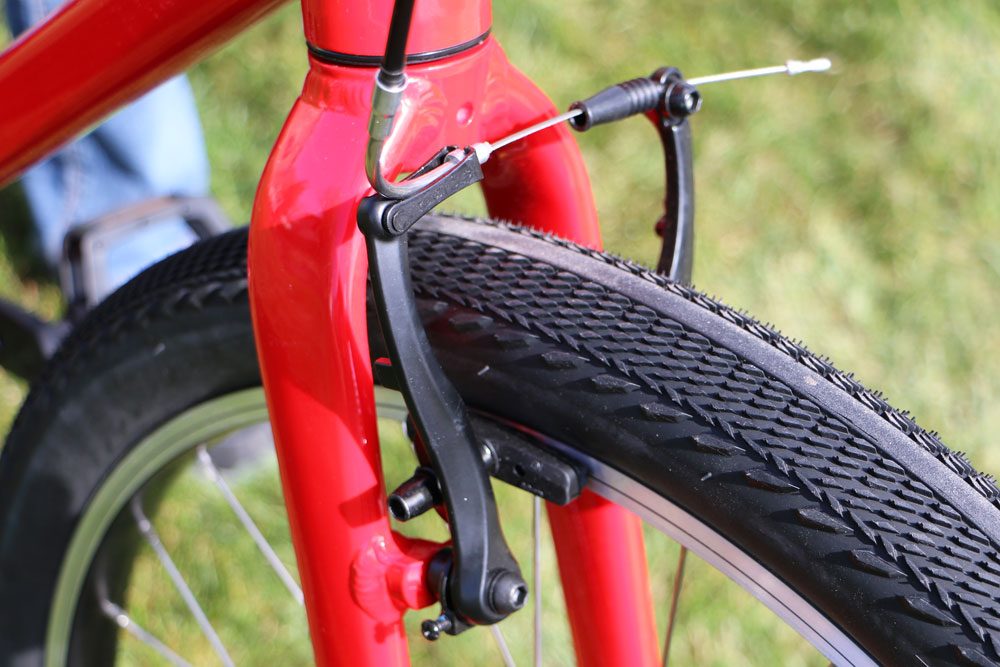
Specialized Jett Kids Bike – Bottom Line
An exceptional bike from top to bottom, the Specialized Jett is packed full of features that kids and parents both love. The smooth and fast ride of the Jett will have kids begging for more time to ride their bike, while parents will no longer dread growth spurts due to the Jett’s extended fit.
With its extended adjustability, the Jett does deliver on its promise of providing a longer fit. How beneficial those extra inches of growth are really depends on how fast your child grows.
In the end, while the Jett didn’t provide as much adjustability as we anticipated, we were incredibly impressed by its quality and performance. Extended fit aside, the Specialized Jett is one of the best kids bikes we’ve ever tested.
All in all, the Jett certainly doesn’t come cheap, but it does come prepared to bring years of smiles backed by Specialized’s lifetime warranty on their frames and fork.
FTC Disclosure: Affiliate links are included in this review. No monetary compensation was provided for this review, however, the reviewed product was supplied by the manufacturer or distributor to help facilitate this review. All opinions and images are that of Two Wheeling Tots LLC. All content and images are copyrighted and should not be used or replicated in any way. View our Terms of Use.
